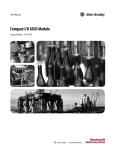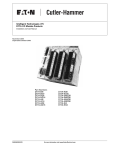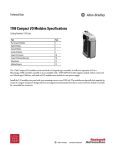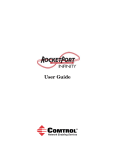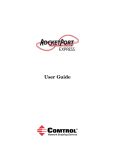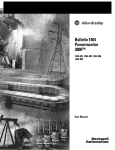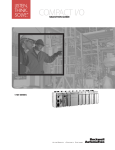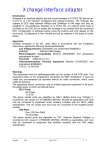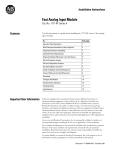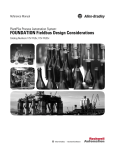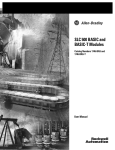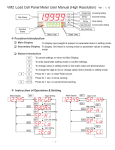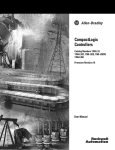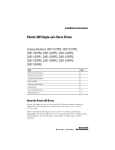Download Compact 1769-ASCII Module
Transcript
Installation Instructions Compact 1769-ASCII Module Cat. No. 1769-ASCII Inside… About the Module ............................................................................................4 Install the Module.............................................................................................5 Assemble the System........................................................................................6 Mount Expansion I/O ....................................................................................8 Ground the Module........................................................................................12 Connect the D-sub Connector Pins ............................................................13 I/O Memory Mapping...................................................................................16 Configure the 1769-ASCII Module .............................................................25 Specifications...................................................................................................29 Status Indicators..............................................................................................32 Troubleshoot with Error Codes ...................................................................33 Publication 1769-IN068B-EN-P - May 2005 2 Compact 1769-ASCII Module Important User Information Because of the variety of uses for the products described in this publication, those responsible for the application and use of these products must satisfy themselves that all necessary steps have been taken to assure that each application and use meets all performance and safety requirements, including any applicable laws, regulations, codes and standards. In no event will Rockwell Automation be responsible or liable for indirect or consequential damage resulting from the use or application of these products. Any illustrations, charts, sample programs, and layout examples shown in this publication are intended solely for purposes of example. Since there are many variables and requirements associated with any particular installation, Rockwell Automation does not assume responsibility or liability (to include intellectual property liability) for actual use based upon the examples shown in this publication. Allen-Bradley publication SGI-1.1, Safety Guidelines for the Application, Installation and Maintenance of Solid-State Control (available from your local Rockwell Automation office), describes some important differences between solid-state equipment and electromechanical devices that should be taken into consideration when applying products such as those described in this publication. Reproduction of the contents of this copyrighted publication, in whole or part, without written permission of Rockwell Automation, is prohibited. Throughout this publication, notes may be used to make you aware of safety considerations. The following annotations and their accompanying statements help you to identify a potential hazard, avoid a potential hazard, and recognize the consequences of a potential hazard: WARNING ATTENTION Identifies information about practices or circumstances that can cause an explosion in a hazardous environment, which may lead to personal injury or death, property damage, or economic loss. Identifies information about practices or circumstances that can lead to personal injury or death, property damage, or economic loss. Publication 1769-IN068B-EN-P - May 2005 Compact 1769-ASCII Module 3 IMPORTANT ATTENTION Identifies information that is critical for successful application and understanding of the product. Environment and Enclosure This equipment is intended for use in a Pollution Degree 2 industrial environment, in overvoltage Category II applications (as defined in IEC publication 60664-1), at altitudes up to 2000 meters without derating. This equipment is considered Group 1, Class A industrial equipment according to IEC/CISPR Publication 11. Without appropriate precautions, there may be potential difficulties ensuring electromagnetic compatibility in other environments due to conducted as well as radiated disturbance. This equipment is supplied as “open type” equipment. It must be mounted within an enclosure that is suitably designed for those specific environmental conditions that will be present and appropriately designed to prevent personal injury resulting from accessibility to live parts. The interior of the enclosure must be accessible only by the use of a tool. Subsequent sections of this publication may contain additional information regarding specific enclosure type ratings that are required to comply with certain product safety certifications. NOTE: See NEMA Standards publication 250 and IEC publication 60529, as applicable, for explanations of the degrees of protection provided by different types of enclosure. Also, see the appropriate sections in this publication, as well as the Allen-Bradley publication 1770-4.1 (“Industrial Automation Wiring and Grounding Guidelines”), for additional installation requirements pertaining to this equipment. Publication 1769-IN068B-EN-P - May 2005 4 Compact 1769-ASCII Module About the Module The 1769-ASCII module provides a flexible network interface to a wide variety of RS-232, RS-485, and RS-422 ASCII devices. The module provides the communication connections to the ASCII device. Item Description 1a 2a 2a 3a 1a Upper DIN rail latch 1b Lower DIN rail latch 2a Upper tongue-and-groove slots 4 2b Lower tongue-and-groove slots 3a Channel 0 isolated ASCII connector 3b Channel 1 isolated ASCII connector 4 Stationary bus connector with male pins 3b 2b 2b 1b Publication 1769-IN068B-EN-P - May 2005 Compact 1769-ASCII Module 5 Install the Module Compact I/O is suitable for use in an industrial environment when installed in accordance with these instructions. Specifically, this equipment is intended for use in clean, dry environments (Pollution Degree 2(1)) and to circuits not exceeding Over Voltage Category II(2) (IEC 60664-1).(3) ATTENTION Preventing Electrostatic Discharge This equipment is sensitive to electrostatic discharge, which can cause internal damage and affect normal operation. Follow these guidelines when you handle this equipment: • Touch a grounded object to discharge potential static. • Wear an approved grounding wriststrap. • Do not touch connectors or pins on component boards. • Do not touch circuit components inside the equipment. • If available, use a static-safe workstation. When not in use, store the equipment in appropriate static-safe packaging. WARNING If you connect or disconnect the serial cable with power applied to this module or the serial device on the other end of the cable, an electrical arc can occur. This can cause an explosion in hazardous locations. Be sure that power is removed or the area is nonhazardous before proceeding. (1) Pollution Degree 2 is an environment where, normally, only non-conductive pollution occurs except that occasionally a temporary conductivity caused by condensation shall be expected. (2) Over Voltage Category II is the load level section of the electrical distribution system. At this level transient voltages are controlled and do not exceed the impulse voltage capability of the product’s insulation. (3) Pollution Degree 2 and Over Voltage Category II are International Electrotechnical Commission (IEC) designations. Publication 1769-IN068B-EN-P - May 2005 6 Compact 1769-ASCII Module ATTENTION This product is grounded through the DIN rail to chassis ground. Use zinc-plated, yellow-chromate steel DIN rail to assure proper grounding. The use of other DIN rail materials (e.g., aluminum, plastic, etc.), which can corrode, oxidize, or are poor conductors, can result in improper or intermittent grounding. Assemble the System Attach the module to the controller or an adjacent I/O module before or after mounting. For mounting instructions, see the Panel Mount or Mount on the DIN Rail sections. To work with a system that is already mounted, see Replace a Single Module Within a System section. 3 4 2 1 6 1 5 Publication 1769-IN068B-EN-P - May 2005 Compact 1769-ASCII Module 7 1. Disconnect power. ATTENTION Remove power before removing or inserting this module. When you remove or insert a module with power applied, an electrical arc may occur. An electrical arc can cause personal injury or property damage by: • sending an erroneous signal to your system’s field devices, causing unintended machine motion • causing an explosion in a hazardous environment Electrical arcing causes excessive wear to contacts on both the module and its mating connector. Worn contacts may create electrical resistance. 2. Check that the bus lever of the module to be installed is in the unlocked (fully right) position. 3. Use the upper and lower tongue-and-groove slots (1) to secure the modules together or to a controller. 4. Move the module back along the tongue-and-groove slots until the bus connectors (2) line up with each other. 5. Use your fingers or a small screwdriver to push the bus lever back slightly to clear the positioning tab (3). 6. To enable communication between the controller and module, move the bus lever fully to the left (4) until it clicks. Ensure it is locked firmly in place. ATTENTION When attaching I/O modules, it is very important that the bus connectors are securely locked together to ensure proper electrical connection. Publication 1769-IN068B-EN-P - May 2005 8 Compact 1769-ASCII Module 7. Attach an end-cap terminator (5) to the last module in the system by using the tongue-and-groove slots as before. 8. Lock the end-cap bus terminator (6). You must use a 1769-ECR or -ECL right- or left-end cap to terminate the end of the serial communication bus. IMPORTANT Mount Expansion I/O ATTENTION During panel or DIN rail mounting of all devices, be sure that all debris (metal chips, wire strands, etc.) is kept from falling into the module. Debris that falls into the module could cause damage on power up. When mounting the CompactLogix system, either use screws to panel mount the system OR use DIN rail. Do NOT use both. Use of both mounting methods may cause hardware damage and cause the system to fail. IMPORTANT Minimum Space Maintain spacing from enclosure walls, wireways, adjacent equipment, etc. Allow 50 mm (2 in) of space on all sides for adequate ventilation. Bottom Publication 1769-IN068B-EN-P - May 2005 End Cap Compact I/O Compact I/O Compact I/O Compact I/O Controller Side Compact I/O Top Side Compact 1769-ASCII Module 9 Panel Mount Mount the module to a panel by using two screws per module. Use M4 or #8 panhead screws. Mounting screws are required on every module. Panel Mount Procedure With the Dimensional Template Compact I/O Right End Cap 28.5 (1.12) 35 (1.38) Compact I/O 122.6±0.2 (4.826±0.008) Compact I/O 132 (5.197) Host Controller For more than 2 modules: (number of modules - 1) X 35 mm (1.38 in.) Refer to host controller documentation for this dimension. NOTE: All dimensions are in mm (inches). Hole spacing tolerance: ±0.4 mm (0.016 in.) Panel Mount Procedure With Modules as a Template The following procedure lets you use the assembled modules as a template for drilling holes in the panel. Due to module mounting hole tolerance, it is important to follow these procedures. 1. On a clean work surface, assemble no more than three modules. 2. Using the assembled modules as a template, carefully mark the center of all module-mounting holes on the panel. 3. Return the assembled modules to the clean work surface, including any previously mounted modules. 4. Drill and tap the mounting holes for the recommended M4 or #8 screw. Publication 1769-IN068B-EN-P - May 2005 10 Compact 1769-ASCII Module 5. Place the modules back on the panel, and check for proper hole alignment. 6. Attach the modules to the panel using the mounting screws. If mounting more modules, mount only the last one of this group and put the others aside. This reduces remounting time during drilling and tapping of the next group. 7. Repeat steps 1 to 6 for any remaining modules. Mount on the DIN Rail The module can be mounted on these DIN rails: • 35 x 7.5 mm (EN 50022 - 35 x 7.5) • 35 x 15 mm (EN 50022 - 35 x 15) Before mounting the module on a DIN rail, close the DIN rail latches. Press the DIN rail mounting area of the module against the DIN rail. The latches will momentarily open and lock into place. Publication 1769-IN068B-EN-P - May 2005 Compact 1769-ASCII Module 11 Replace a Single Module Within a System The module can be replaced while the system is mounted to a panel or DIN rail. 1. Remove power. ATTENTION Remove power before removing or inserting this module. When you remove or insert a module with power applied, an electrical arc may occur. An electrical arc can cause personal injury or property damage by: • sending an erroneous signal to your system’s field devices, causing unintended machine motion • causing an explosion in a hazardous environment Electrical arcing causes excessive wear to contacts on both the module and its mating connector. Worn contacts may create electrical resistance. 2. On the module to be removed, remove the upper and lower mounting screws from the module (or open the DIN latches using a flat-blade or Phillips-style screwdriver). 3. Move the bus lever to the right to disconnect (unlock) the bus. 4. Move the bus lever on the right-side adjacent module to the right (unlock) to disconnect it from the module to be removed. 5. Gently slide the disconnected module forward. If you feel excessive resistance, check that the module has been disconnected from the bus, and that both mounting screws have been removed (or DIN latches opened). You may need to rock the module slightly from front to back to remove it, or, in a panel-mounted system, to loosen the screws of adjacent modules. Publication 1769-IN068B-EN-P - May 2005 12 Compact 1769-ASCII Module 6. Before installing the replacement module, be sure that the bus lever on the module to be installed and on the right-side adjacent module are in the unlocked (fully right) position. 7. Slide the replacement module into the open slot. 8. Connect the modules together by locking (fully left) the bus levers on the replacement module and the right-side adjacent module. 9. Replace the mounting screws (or snap the module onto the DIN rail). Ground the Module This product is intended to be mounted to a well-grounded mounting surface such as a metal panel. Additional grounding connections from the module’s mounting tabs or DIN rail (if used) are not required unless the mounting surface cannot be grounded. Refer to Industrial Automation Wiring and Grounding Guidelines, publication 1770-4.1, for additional information. Publication 1769-IN068B-EN-P - May 2005 Compact 1769-ASCII Module 13 Connect the D-sub Connector Pins All pins are active at all times. IMPORTANT Pins unused for a particular physical network must not be connected via the serial cable to any other device. In particular, do not use cables 1747-CP3 and 1756-CP3. Pin RS-232 RS-422 RS-485 1 Do Not Connect Transmit Data - Transmit/Receive Data - 2 Receive Data Do Not Connect Do Not Connect 3 Transmit Data Do Not Connect Do Not Connect 4 Do Not Connect Receive Data - Do Not Connect 5 Common Common Common 6 Do Not Connect Receive Data + Do Not Connect 7 Request To Send Request To Send Request To Send 8 Clear To Send Clear To Send Clear To Send 9 Do Not Connect Transmit Data + Transmit/Receive Data + Publication 1769-IN068B-EN-P - May 2005 14 Compact 1769-ASCII Module Figure 1 RS-232 Wiring Diagram - Module to DTE Device (Hardware Handshaking Disabled) ASCII DTE DTE 1 NC DCD 2 RXD TXD 3 TXD RSD 4 NC DSR 5 COM COM 6 NC DTR 7 8 RTS CTS CTS RTS 9 NC GND(1) 9-pin 25-pin 1 3 2 6 5 4 8 7 8 2 3 6 7 20 5 4 1 (1) Connect to the shield of the cable. Figure 2 RS-232 Wiring Diagram - Module to Printer (Hardware Handshaking Enabled, Standard Printer Adapter Cable) ASCII DTE 1 NC 2 3 4 5 6 7 8 9 RXD TXD NC COM NC RTS CTS N.C. Publication 1769-IN068B-EN-P - May 2005 DTE CD TXD RXD DSR COM DTR CTS RTS RI GND 9-pin 1 25-pin 8 3 2 6 5 4 8 7 9 2 3 6 7 20 5 4 22 1 Compact 1769-ASCII Module 15 Figure 3 RS-422 Wiring Diagram ASCII 1 TXD- 2 NC NC 3 4 RXD5 COM 6 RXD+ RXD- TXDCOM TXD+ 7 8 RTS CTS 9 TXD+ RXD+ Figure 4 RS-485 Wiring Diagram ASCII 1 TRXD2 NC 3 4 5 6 NC NC COM NC TRXD- COM 7 8 RTS CTS 9 TRXD+ TRXD+ Publication 1769-IN068B-EN-P - May 2005 16 Compact 1769-ASCII Module I/O Memory Mapping The 1769-ASCII module supports an input assembly that is accessible through the Assembly Object (Class 4), Instance 101. The input assembly is up to 108 words. The module supports an output assembly that is accessible through the Assembly Object (Class 4), Instance 100. The output assembly is up to 108 words. Alternate Mode (One Channel at a Time) Output File Word Maximum size is shown below. Refer to the Compact I/O 1769-ASCII Module User Manual, publication 1769-UM012, to use smaller output files. Bit Position 15 14 13 12 11 10 9 8 7 6 5 4 3 2 1 0 Reserved Tx Transaction ID Ch0 1 Reserved Rx Transaction ID Request Ch0 2 Reserved Tx Transaction ID Ch1 3 Reserved Rx Transaction ID Request Ch1 0 4 Reserved CNI 5 Reserved CNO 6 Reserved 7 Length (Number of Bytes) 8 Character 1 Character 0 9 Character 3 Character 2 … Character … Character … 106 Character 197 Character 196 107 Character 199 Character 198 • Tx = Transmit • Rx = Receive • CNI = Channel number of requested input data. This bit is set by the PLC controller or other user program to tell the ASCII module which data to produce. Publication 1769-IN068B-EN-P - May 2005 Compact 1769-ASCII Module 17 • CNO = Channel number of the output data being sent. This bit is set by the PLC controller or other user program to tell the ASCII module which port’s data is being sent to the ASCII module. • Reserved bits should be set to 0. Alternate Mode (One Channel at a Time) Input File Word Maximum size is shown below. Refer to the Compact I/O 1769-ASCII Module User Manual, publication 1769-UM012, to use smaller input files. Bit Position 15 14 0 1 12 11 10 9 15 14 13 12 11 15 14 13 12 11 6 5 4 3 2 1 Rx Transaction ID Ch1 10 TG1 TS1 ND HE1 NR RF1 TF1 PA1 RO1 TO1 1 1 Reserved CNI Reserved Firmware Revision, Major 7 0 Rx Transaction ID Ch0 Tx ID 1 Acknowledged 5 8 7 10 TG0 TS0 ND HE0 NR RF0 TF0 PA0 RO0 TO0 0 0 4 6 8 Tx ID 0 Acknowledged 2 3 13 CNO Firmware Revision, Minor Length (Number of Bytes) Character 1 Character 0 9 Character 3 Character 2 … Character … Character … 106 Character 197 Character 196 107 Character 199 Character 198 • Tx = Transmit • Rx = Receive • TS = Transmit sent. Indicates the ASCII module has sent the data indicated by the Tx Transaction ID and can accept more transmit data. • ND = New data. Only used for Handshake mode. • HE = Handshake error. Only used for Handshake mode. Publication 1769-IN068B-EN-P - May 2005 18 Compact 1769-ASCII Module • NR = Non-delimited record. An input record is received and sent to the Compact bus interface that was not triggered by a delimiter character. This occurs when either the buffer is filled to its maximum receive size or a Message Timeout has occurred. • RF = Data in the receive FIFO. The FIFO is not empty. The input FIFO has not sent all of its data to the Compact bus interface. • TF = Data in transmit FIFO. The FIFO is not empty. The output FIFO has not sent all of its data to the ASCII device. • PA = Parity error. A parity error has occurred with the received data string. This usually indicates a mismatch in the serial port set-up of the ASCII device and the Compact module. It could also indicate that noise has occurred on the line and degraded the signal. This bit is set when the receive FIFO contains a message in which a parity error occurred in one of the incoming bytes. This bit is reset when the receive FIFO is emptied or when a new message is received with no parity error. • RO = Receive buffer overflow. Some input data has been lost. • TG = Transmit greater than Max Error. Transmit length in the output file is greater than the maximum transmit character length in the configuration file. • TO = Transmit buffer overflow. Some output data has been lost. • CNI = Channel number of the input data. This bit is set by the ASCII module to tell the user program from which port the data was received. • CNO = Channel number of the output data most recently received. This bit is set by the ASCII module to tell the user program that it has received the data to transmit out the specified port. Publication 1769-IN068B-EN-P - May 2005 Compact 1769-ASCII Module 19 Simultaneous Mode (Two Channels) Input File Word Maximum size is shown below. Refer to the Compact I/O 1769-ASCII Module User Manual, publication 1769-UM012, to use smaller output files. Bit Position 15 14 13 12 11 10 9 8 7 6 5 4 3 2 1 0 Channel 0 Data 0 1 2 Tx ID Acknowledged Reserved TG TS ND HE NR RF Firmware Revision, Major 3 4 Rx Transaction ID TF PA RO TO Firmware Revision, Minor Length (Number of Bytes) Character 1 Character 0 5 Character 3 Character 2 … Character … Character … x(1) Last Character Character … x+1 Tx ID Acknowledged x+2 Reserved Channel 1 Data x+3 Rx Transaction ID TG TS ND HE NR RF Firmware Revision, Major x+4 TF Firmware Revision, Minor Length (Number of Bytes) x+5 Character 1 Character 0 x+6 Character 3 Character 2 … Character … Character … (2) Last Character Character … y PA RO TO (1) X is calculated based on the size of Channel 0 data as specified in the input file. Both channels cannot contain 200 characters as the total configuration file size can be only 108 words. (2) Y is equal to the connection size minus 1, with a maximum value of 107 for a buffer size of 108. • Tx = Transmit • Rx = Receive • TG = Transmit greater than Max Error. Transmit length in the output file is greater than the maximum transmit character length in the configuration file. Publication 1769-IN068B-EN-P - May 2005 20 Compact 1769-ASCII Module • TS = Transmit sent. Indicates the ASCII module has sent the data indicated by the Tx Transaction ID and can accept more transmit data. • ND = New data. Only used for Handshake mode. • HE = Handshake error. Only used for Handshake mode. • NR = Non-delimited record. An input record is received and sent to the Compact bus interface that was not triggered by a delimiter character. This occurs when either the buffer is filled to its maximum receive size or a Message Timeout has occurred. • RF = Data in the receive FIFO. The FIFO is not empty. The input FIFO has not sent all of its data to the Compact bus interface. • TF = Data in transmit FIFO. The FIFO is not empty. The output FIFO has not sent all of its data to the ASCII device. • PA = Parity error. A parity error has occurred with the received data string. This usually indicates a mismatch in the serial port set-up of the ASCII device and the Compact module. It could also indicate that noise has occurred on the line and degraded the signal. This bit is set when the receive FIFO contains a message in which a parity error occurred in one of the incoming bytes. This bit is reset when the receive FIFO is emptied or when a new message is received with no parity error. • RO = Receive buffer overflow. Some input data has been lost. • TO = Transmit buffer overflow. Some output data has been lost. Publication 1769-IN068B-EN-P - May 2005 Compact 1769-ASCII Module 21 Simultaneous Mode (Two Channels) Output File Word Maximum size is shown below. Refer to the Compact I/O 1769-ASCII Module User Manual, publication 1769-UM012, to use smaller output files. Bit Position 15 14 13 12 11 10 9 8 7 6 5 4 3 2 1 0 Channel 0 Data 0 Reserved 1 Reserved 2 Rx Transaction ID Request Reserved 3 4 Tx Transaction ID Length (Number of Bytes) Character 1 Character 0 5 Character 3 Character 2 … Character … Character … x(1) Last Character Character … x+1 Reserved Tx Transaction ID x+2 Reserved Rx Transaction ID Request Channel 1 Data x+3 Reserved x+4 Length (Number of Bytes) x+5 Character 1 Character 0 x+6 Character 3 Character 2 … Character … Character … (2) Last Character Character … y (1) X is calculated based on the size of Channel 0 data as specified in the configuration file. Both channels cannot contain 200 characters as the total configuration file size can be only 108 words. (2) Y is equal to the connection size minus 1, with a maximum value of 107 for a buffer size of 108. • Tx = Transmit • Rx = Receive Publication 1769-IN068B-EN-P - May 2005 22 Compact 1769-ASCII Module Configuration File Word The 1769-ASCII module supports a configuration assembly that is accessible through the Assembly Object (Class 4), Instance 102. The configuration assembly is 31 words. The addresses assume a 16-bit data structure where all 16-bit values are INT(1). The least significant word occupies the smaller byte addresses. 0 Description Values Valid Data Values Data Buffer Mode 0…1 0 = alternate mode 1 = simultaneous mode Channel 0 1 Serial Character Framing 0…8 0 = 7N2, 1 = 7E1, 2 = 7O1, 3 = 8N1, 4 = 8N2, 5 = 8E1, 6 = 8O1, 7 = 7E2, 8 = 7O2 2 Serial Port Speed 0…7 0 = 9600, 1 = 1200, 2 = 2400, 3 = 4800, 4 = 19200, 5 = 38400, 6 = 57.6k, 7 = 115.2k (half-duplex only) Serial Port Receive Data 3 Max Number of Receive Characters 0…200 In Simultaneous mode, the total number of channel 0 characters plus channel 1 characters cannot exceed 200. 4 Receive Record Start Mode 0…2 0 = ignore, 1 = exclude, 2 = include start delimiter 5 Receive Start Delimiter(1) 0…127/255 0…0x7f (0…127) for 7-bit data 0…0xff (0…255) for 8-bit data 6 Receive Record End Mode 0…2 7 Receive End Delimiter(1) 0…127/255 0…0x7f (0…127) for 7-bit data 0…0xff (0…255) for 8-bit data (1) 0 = ignore, 1 = exclude, 2 = include end delimiter INT = Integer range of -32768 to +32767 decimal, 0000 to FFFF hexadecimal. Publication 1769-IN068B-EN-P - May 2005 Word Compact 1769-ASCII Module 23 Description Values Valid Data Values Module Production Data 8 Pad Character(1) 0…127/255 0…0x7f (0…127) for 7-bit data 0…0xff (0…255) for 8-bit data 9 Receive Swap Mode 0…2 0 = disabled, 1 = 16-bit, 2 = 32-bit 10 Master Handshake Mode 0…1 0 = master/slave handshake, 1 = produce immediate 11 Message Time Out 0…65535 0 = none, 1 to 65535 ms 12 Max Number of Transmit Characters 0…200 In Simultaneous mode, the total number of channel 0 characters plus channel 1 characters cannot exceed 200. 13 Transmit Record End Mode 0…2 0 = ignore, 1 = exclude, 2 = include end delimiter 14 Transmit End Delimiter(1) 0…127/255 0…0x7f (0…127) for 7-bit data 0…0xff (0…255) for 8-bit data 15 Transmit Swap Mode 0…2 0 = disabled, 1 = 16-bit, 2 = 32-bit 16 Serial Character Framing 0…8 0 = 7N2, 1 = 7E1, 2 = 7O1, 3 = 8N1, 4 = 8N2, 5 = 8E1, 6 = 8O1, 7 = 7E2, 8 = 7O2 17 Serial Port Speed 0…7 0 = 9600, 1 = 1200, 2 = 2400, 3 = 4800, 4 = 19200, 5 = 38400, 6 = 57.6k, 7 = 115.2k (half-duplex only) Serial Port Transmit Data Channel 1 Publication 1769-IN068B-EN-P - May 2005 Word 24 Compact 1769-ASCII Module Description Values Valid Data Values 18 Max Number of Receive Characters 0…200 In Simultaneous mode, the total number of channel 0 characters plus channel 1 characters cannot exceed 200. 19 Receive Record Start Mode 0…2 0 = ignore, 1 = exclude, 2 = include start delimiter 20 Receive Start Delimiter(1) 0…127/255 0…0x7f (0…127) for 7-bit data 0…0xff (0…255) for 8-bit data 21 Receive Record End Mode 0…2 22 Receive End Delimiter(1) 0…127/255 0…0x7f (0…127) for 7-bit data 0…0xff (0…255) for 8-bit data Serial Port Receive Data 0 = ignore, 1 = exclude, 2 = include end delimiter Module Production Data 23 Pad Character(1) 0…127/255 0…0x7f (0…127) for 7-bit data 0…0xff (0…255) for 8-bit data 24 Receive Swap Mode 0…2 0 = disabled, 1 = 16-bit, 2 = 32-bit 25 Master Handshake Mode 0…1 0 = master/slave handshake, 1 = produce immediate 26 Message Time Out 0…65535 0 = none, 1 to 65535 ms 27 Max Number of Transmit Characters 0…200 In Simultaneous mode, the total number of channel 0 characters plus channel 1 characters cannot exceed 200. 28 Transmit Record End Mode 0…2 0 = ignore, 1 = exclude, 2 = include end delimiter 29 Transmit End Delimiter(1) 0…127/255 0…0x7f (0…127) for 7-bit data 0…0xff (0…255) for 8-bit data 30 Transmit Swap Mode 0…2 Serial Port Transmit Data (1) 0 = disabled, 1 = 16-bit, 2 = 32-bit To enter values from +128 to +255, use this conversion formula: Desired Decimal Value - 256 = Entered Decimal Value. For example, for an ASCII character value of 128, 128 - 256 = -128. Publication 1769-IN068B-EN-P - May 2005 Compact 1769-ASCII Module 25 Configure the 1769-ASCII Module Enter the configuration data for your 1769-ASCII application into RSLogix 500 software or RSLogix 5000 software. If your message sizes differ from the default, change the size of the input and output connection parameters. Configure with RSLogix 500 Software RSLogix 500, version 7, will include a 1769-ASCII profile. If you use a previous version, follow this procedure to configure your module. 1. From the list, choose Other: Requires I/O Card Type ID. Publication 1769-IN068B-EN-P - May 2005 26 Compact 1769-ASCII Module 2. Enter the appropriate values as listed below. 3. Choose OK. 4. From the Generic Extra Data Config tab, enter your configuration data. Refer to Configuration File on page 22. Publication 1769-IN068B-EN-P - May 2005 Compact 1769-ASCII Module 27 Configure with RSLogix 5000 Software 1. Right-click on the 1769-ASCII module and choose Properties. Use the default Assembly Instance numbers. 2. Enter the name of your module in the Name field. 3. Enter the connection parameters according to your controller. Controller 1769-L31, -L32C, -L32E, -L35CR, -L35E (1) Maximum size listed. (2) The created tag will be 198 INTs long. Input Output Configuration Size(1) Size(1) Size(2) 108 108 31 4. Choose OK. Publication 1769-IN068B-EN-P - May 2005 28 Compact 1769-ASCII Module 5. Double-click on the controller tags. 6. Enter your configuration data. Refer to Configuration File on page 22. For this example, we entered the Serial Character Framing from Word 1. Publication 1769-IN068B-EN-P - May 2005 Compact 1769-ASCII Module 29 Specifications Vendor I.D. Code 1 Product Type Code 109 Product Code 66 Input Words 108 Output Words 108 Configuration Words 31 Recommended Cable BeldenTM 8761 (shielded) Number of Inputs 2 full duplex (RS-232, RS-422) 2 half duplex (RS-485) Serial Input Voltage Signal 3…25V dc with respect to signal ground (SG) “0”, Asserted, ON, Space, Active -3…-25V dc with respect to signal ground (SG) “1”, Disasserted, OFF, Mark, Inactive Bus Current 425 mA @ 5V dc Power Dissipation, Max. 2.13 W Thermal Dissipation, Max. 7.3 BTU/hr Power Supply Distance Rating 4 Isolation Voltage 30V Tested to withstand 710V dc for 60 s Serial Port Status TX FIFO overflow, RX FIFO overflow, RX parity error, handshake error, new data flag Produce Assembly Size 108 words Consume Assembly Size 108 words Transmit Transaction ID 0…255 Handshaking RTS/CTS hardware handshake always enabled Publication 1769-IN068B-EN-P - May 2005 30 Compact 1769-ASCII Module General Specifications Environmental Conditions Operational Temperature IEC 60068-2-1 (Test Ad, Operating Cold), IEC 60068-2-2 (Test Bd, Operating Dry Heat), IEC 60068-2-14 (Test Nb, Operating Thermal Shock): 0…60 °C (32…140 °F) Storage Temperature IEC 60068-2-1 (Test Ab, Unpackaged Non-operating Cold), IEC 60068-2-2 (Test Bb, Unpackaged Non-operating Dry Heat), IEC 60068-2-14 (Test Na, Unpackaged Non-operating Thermal Shock): -40…85 °C (-40…185 °F) Relative Humidity IEC 60068-2-30 (Test Db, Unpackaged Non-operating Damp Heat): 5…95% non-condensing Vibration IEC 60068-2-6 (Test Fc, Operating) 5g @ 10…500 Hz Operating Shock IEC 60068-2-27 (Test Ea, Un-packaged Shock): 30g Non-operating Shock IEC 60068-2-27 (Test Ea, Un-packaged Shock): 50g Emissions CISPR 11: Group 1, Class A ESD Immunity IEC 61000-4-2: 4 kV contact discharges 8 kV air discharges Radiated RF Immunity IEC 61000-4-3: 10 V/m with 1 kHz sine-wave 80% AM from 30…2000 MHz 10 V/m with 200 Hz 50% pulse 100% AM from 900 MHz 10 V/m with 200 Hz 50% pulse 100% AM at 1890 MHz EFT/B Immunity IEC 61000-4-4: +2 kV at 5kHz on communications ports Surge Transient Immunity IEC 61000-4-5: +2 kV line-earth (CM) on communications ports Publication 1769-IN068B-EN-P - May 2005 Compact 1769-ASCII Module 31 Conducted RF Immunity IEC 61000-4-6: 10 Vrms with 1 kHz sine-wave 80% AM from 150 kHz…80 MHz Enclosure Type Rating None (open-style) Dimensions (HxWxL), Imperial 3.39 x 1.33 x 4.60 in Dimensions (HxWxL), Metric 87 x 34 x 118 mm Serial Port Connectors Two DB-9 male (with pins) Conductors Category 21 Weight, Imperial 0.4 lb Weight, Metric 0.18 kg Certifications (when product is marked) c-UL-us2 - UL Listed for Class I, Division 2 Group A, B, C, D Hazardous Locations, certified for U.S. and Canada CE2 - European Union 89/335/EEC EMC Directive, compliant with: EN 50082-2; Industrial Immunity EN 61326; Meas./Control/Lab., Industrial Requirements EN 61000-6-2; Industrial Immunity EN 61000-6-4; Industrial Emissions C-Tick2 - Australian Radiocommunications Act, compliant with: AS/NZS CISPR 11; Industrial Emissions 1 Use this conductor category information for planning conductor routing as described in publication 1770-4.1, “Industrial Automation Wiring and Grounding Guidelines.” 2 See the Product Certification link at www.ab.com for Declaration of Conformity, Certificates, and other certification details. Publication 1769-IN068B-EN-P - May 2005 32 Compact 1769-ASCII Module Status Indicators The following table defines the ASCII module status indicators. Status Indicator State Meaning OK Off No power, module is not configured, or no bus master Solid green In run mode. The led will blink red once during powerup. Blinking green Bus master is detected, configuration is accepted, and in program mode Blinking red Module configuration from bus master was not valid Tx0, Tx1 Blinking green Transmitting data on that serial port Rx0, Rx1 Blinking green Receiving data on that serial port Publication 1769-IN068B-EN-P - May 2005 Compact 1769-ASCII Module 33 Troubleshoot with Error Codes Value (Hex) Meaning 0 No error 200…3FF Hardware error 400…5FF Configuration error 800…DFF Reserved for future use E00…FFF Bus master detected error Configuration Error Codes Value (Hex) Meaning Description Global Module Errors 0 No error The 1769-ASCII module adds no module-specific errors. 401 Max output array size exceeded The maximum output array size is too large. In alternating mode, channel 0 and channel 1 must have less than 496 transmit characters. In simultaneous mode, channel 0 and channel 1 must have less than 496 transmit characters collectively. 402 Max input array size exceeded The maximum input array size is too large. In alternating mode, channel 0 and channel 1 must have less than 496 receive characters. In simultaneous mode, channel 0 and channel 1 must have less than 496 receive characters collectively. Publication 1769-IN068B-EN-P - May 2005 34 Compact 1769-ASCII Module Value (Hex) Meaning Description Channel 0 Module Errors 430 Data buffer mode 0 = alternate mode; 1 = simultaneous mode. Anything else is invalid. 440 Invalid serial port framing The serial port framing specified is invalid. 441 Invalid serial port speed The serial port speed specified is invalid. 442 Invalid max number of receive characters The maximum number of receive characters specified for channel 0 is too large. 443 Invalid receive record mode The receive record mode specified is invalid. 444 Invalid receive start delimiter The receive start delimiter specified is invalid. 445 Invalid receive record end mode The receive record end mode specified is invalid. 446 Invalid receive record end delimiter The receive record end delimiter specified is invalid. 447 Invalid pad character The pad character specified is invalid. 448 Invalid receive swap mode The receive swap mode specified is invalid. 449 Invalid master handshake mode The master handshake mode specified is invalid. 44A Invalid message timeout The timeout delay specified is invalid. 44B Invalid max number of transmit characters The transmit characters specified is invalid. 44C Invalid transmit record end mode The transmit record end mode specified is invalid. 44D Invalid transmit end delimiter The transmit end delimiter specified is invalid. Publication 1769-IN068B-EN-P - May 2005 Compact 1769-ASCII Module 35 Value (Hex) Meaning Description 44E Invalid transmit swap mode The transmit swap mode specified is invalid. 44F-77F Undefined channel 0 error An undefined error has occurred. Channel 1 Module Errors 480 Invalid serial port framing The serial port framing specified is invalid. 481 Invalid serial port speed The serial port speed specified is invalid. 482 Invalid max number of receive characters The maximum number of receive characters specified for channel 1 is too large. 483 Invalid receive record mode The receive record mode specified is invalid. 484 Invalid receive start delimiter The receive start delimiter specified is invalid. 485 Invalid receive record end mode The receive record end mode specified is invalid. 486 Invalid receive record end delimiter The receive record end delimiter specified is invalid. 487 Invalid pad character The pad character specified is invalid. 488 Invalid receive swap mode The receive swap mode specified is invalid. 489 Invalid master handshake mode The master handshake mode specified is invalid. 48A Invalid message timeout The timeout delay specified is invalid. 48B Invalid max number of transmit characters The transmit characters specified is invalid. Publication 1769-IN068B-EN-P - May 2005 36 Compact 1769-ASCII Module Value (Hex) Meaning Description 48C Invalid transmit record end mode The transmit record end mode specified is invalid. 48D Invalid transmit end delimiter The transmit end delimiter specified is invalid. 48E Invalid transmit swap mode The transmit swap mode specified is invalid. Publication 1769-IN068B-EN-P - May 2005 Compact 1769-ASCII Module 37 North American Hazardous Location Approval The following information applies when operating this equipment in hazardous locations: Informations sur l'utilisation de cet équipement en environnements dangereux: Products marked “CL I, DIV 2, GP A, B, C, D” are suitable for use in Class I Division 2 Groups A, B, C, D, Hazardous Locations and nonhazardous locations only. Each product is supplied with markings on the rating nameplate indicating the hazardous location temperature code. When combining products within a system, the most adverse temperature code (lowest “T” number) may be used to help determine the overall temperature code of the system. Combinations of equipment in your system are subject to investigation by the local Authority Having Jurisdiction at the time of installation. Les produits marqués “CL I, DIV 2, GP A, B, C, D” ne conviennent qu'à une utilisation en environnements de Classe I Division 2 Groupes A, B, C, D dangereux et non dangereux. Chaque produit est livré avec des marquages sur sa plaque d'identification qui indiquent le code de température pour les environnements dangereux. Lorsque plusieurs produits sont combinés dans un système, le code de température le plus défavorable (code de température le plus faible) peut être utilisé pour déterminer le code de température global du système. Les combinaisons d'équipements dans le système sont sujettes à inspection par les autorités locales qualifiées au moment de l'installation. Publication 1769-IN068B-EN-P - May 2005 38 Compact 1769-ASCII Module WARNING EXPLOSION HAZARD AVERTISSEMENT RISQUE D'EXPLOSION Do not disconnect equipment unless power has been removed or the area is known to be nonhazardous. Couper le courant ou s'assurer que l'environnement est classé non dangereux avant de débrancher l'équipement. Do not disconnect connections to this equipment unless power has been removed or the area is known to be nonhazardous. Secure any external connections that mate to this equipment by using screws, sliding latches, threaded connectors, or other means provided with this product. Couper le courant ou s'assurer que l'environnement est classé non dangereux avant de débrancher les connecteurs. Fixer tous les connecteurs externes reliés à cet équipement à l'aide de vis, loquets coulissants, connecteurs filetés ou autres moyens fournis avec ce produit. Substitution of components may impair suitability for Class I, Division 2. La substitution de composants peut rendre cet équipement inadapté à une utilisation en environnement de Classe I, Division 2. If this product contains batteries, they must only be changed in an area known to be nonhazardous. S'assurer que l'environnement est classé non dangereux avant de changer les piles. Compact and RSLogix are trademarks of Rockwell Automation, Inc. Trademarks not belonging to Rockwell Automation are property of their respective companies. Publication 1769-IN068B-EN-P - May 2005 Compact 1769-ASCII Module 39 Notes: Publication 1769-IN068B-EN-P - May 2005 Rockwell Automation Support Rockwell Automation provides technical information on the web to assist you in using its products. At http://support.rockwellautomation.com, you can find technical manuals, a knowledge base of FAQs, technical and application notes, sample code and links to software service packs, and a MySupport feature that you can customize to make the best use of these tools. For an additional level of technical phone support for installation, configuration and troubleshooting, we offer TechConnect Support programs. For more information, contact your local distributor or Rockwell Automation representative, or visit http://support.rockwellautomation.com. Installation Assistance If you experience a problem with a hardware module within the first 24 hours of installation, please review the information that's contained in this manual. You can also contact a special Customer Support number for initial help in getting your module up and running: United States 1.440.646.3223 Monday – Friday, 8am – 5pm EST Outside United States Please contact your local Rockwell Automation representative for any technical support issues. New Product Satisfaction Return Rockwell tests all of its products to ensure that they are fully operational when shipped from the manufacturing facility. However, if your product is not functioning and needs to be returned: United States Contact your distributor. You must provide a Customer Support case number (see phone number above to obtain one) to your distributor in order to complete the return process. Outside United States Please contact your local Rockwell Automation representative for return procedure. Publication 1769-IN068B-EN-P - May 2005 Supersedes Publication 1769-IN068A-EN-P - May 2005 PN 957955-78 Copyright © 2005 Rockwell Automation, Inc. All rights reserved. Printed in the U.S.A.








































